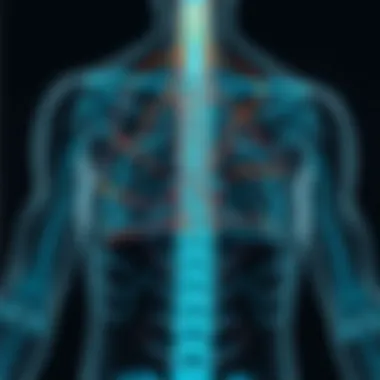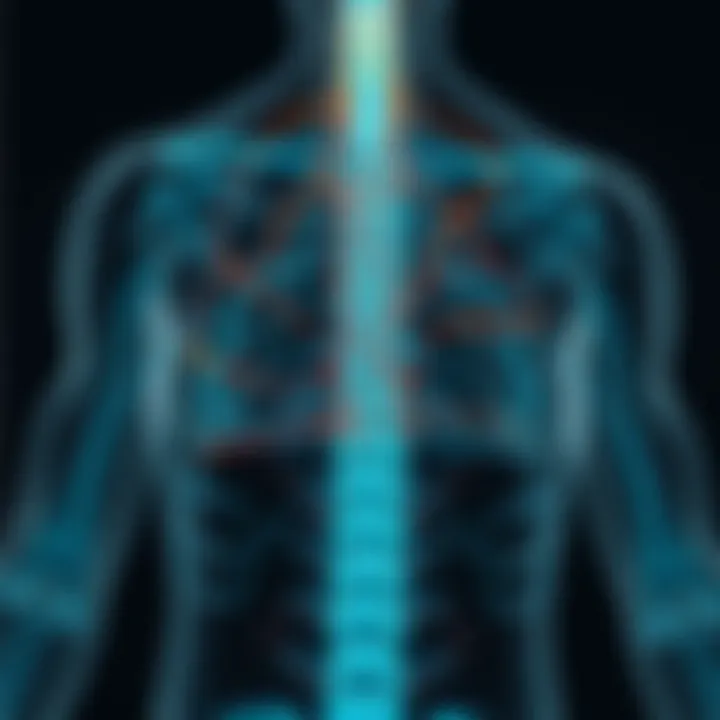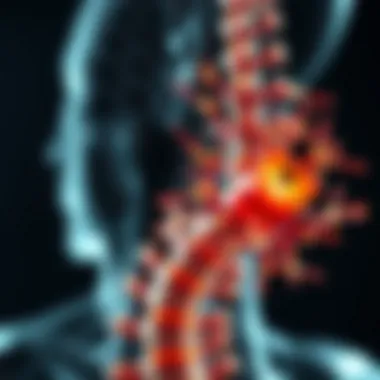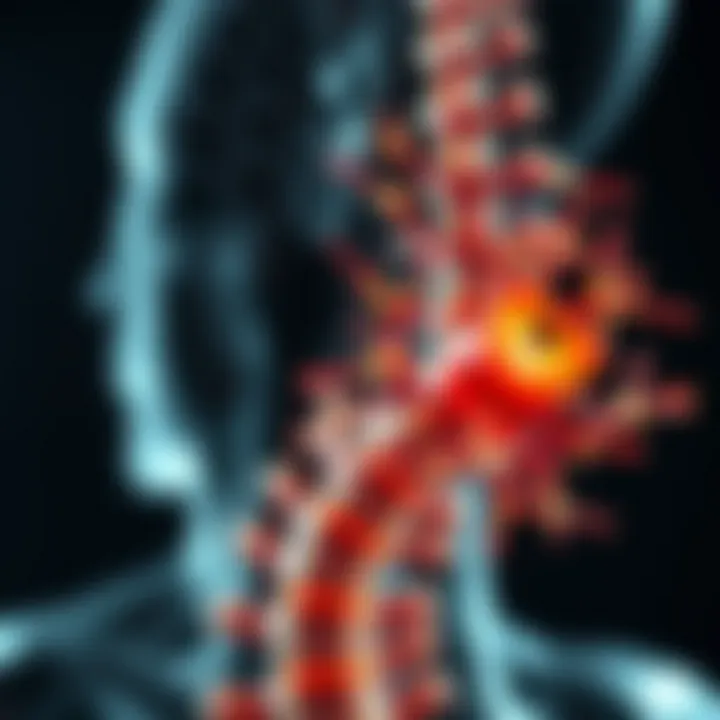Exploring Spinal Ataxia: Mechanisms and Research Advances


Article Overview
Purpose of the Article
The focus of this article is to delve into the multifaceted condition of spinal ataxia, unraveling its complex mechanisms, various impacts on individuals' lives, and the ongoing research aimed at alleviating its challenges. Spinal ataxia, a disorder characterized by impaired coordination and balance, presents an intricate puzzle, and understanding its nature is critical for medical professionals and researchers alike. Through careful examination, we aim to shed light on the condition’s intricacies, offering insights that may improve diagnosis, treatment, and ultimately the quality of life for those affected.
Relevance to Multiple Disciplines
The study of spinal ataxia stretches across several fields, from neurology and genetics to rehabilitation and psychology. Here are a few ways different disciplines engage with this condition:
- Neurology: Understanding the neural pathways affected by spinal ataxia and exploring potential neurological interventions.
- Genetics: Investigating the hereditary factors contributing to various forms of ataxia and their underlying genetic mechanisms.
- Rehabilitation Science: Developing therapeutic strategies aimed at improving motor function and balance through physiotherapy and occupational therapy.
- Psychology: Addressing the emotional and psychological challenges faced by individuals living with spinal ataxia, focusing on mental well-being and coping strategies.
Research Background
Historical Context
The journey to understand spinal ataxia can be traced back through a history rich in exploration and inquiry. Early observations by medical pioneers laid the groundwork for subsequent discoveries in the 19th and 20th centuries. Significant advancements in imaging technology and genetic sequencing have revolutionized our understanding in recent decades. With novel insights into its pathology, researchers are now better equipped to address the various forms of ataxia, including inherited and sporadic cases.
Key Concepts and Definitions
To navigate the complexities of spinal ataxia, it is crucial to establish a foundational vocabulary. Key terms include:
- Ataxia: A general term for a lack of voluntary coordination of muscle movements, often affecting gait and balance.
- Spinocerebellar Pathways: Neural pathways that transmit information between the spinal cord and cerebellum, critical for coordination.
- Genetic Variants: Specific changes in an individual’s DNA that can contribute to the risk of developing certain types of ataxia.
The interplay between these concepts lays the groundwork for comprehensively understanding spinal ataxia.
"The complex nature of spinal ataxia invites ongoing investigation and collaboration among specialists in various fields. Only through interdisciplinary efforts can we hope to untangle its challenges and improve outcomes for patients."
"The complex nature of spinal ataxia invites ongoing investigation and collaboration among specialists in various fields. Only through interdisciplinary efforts can we hope to untangle its challenges and improve outcomes for patients."
This foundational knowledge will set the stage for a deeper exploration of spinal ataxia's impacts and research advances, while inviting both novice learners and experienced professionals to engage with these pressing topics.
Understanding Spinal Ataxia
Spinal ataxia represents a significant challenge in the field of neurology. Understanding this condition is of utmost importance as it lays the groundwork for improving diagnosis, treatment, and overall patient care. Individuals suffering from spinal ataxia experience substantial difficulties in coordination and balance, which can severely impair their daily lives. By delving into its various aspects, we can better comprehend the intricate mechanisms that contribute to this disorder, its historic evolution, and the lived experiences of those impacted.
A thorough understanding of spinal ataxia encompasses multiple dimensions, including clinical manifestations, underlying physiological and genetic mechanisms, and familial effects. It also highlights the relevance of research advancements that can lead to innovative therapies and management strategies. Recognizing these elements allows practitioners, researchers, and educators to work collaboratively towards better outcomes for patients.
Definition and Overview
Spinal ataxia is defined as a form of ataxia characterized by compromised voluntary coordination of muscle movements, primarily due to dysfunction in the spinal cord or cerebellum. This disorder manifests through varying degrees of instability, lack of coordination, and difficulties in posture. It affects both fine and gross motor skills, leading to challenges in activities ranging from simple movements to complex tasks.
The term "ataxia" itself originates from Greek, meaning "lack of order". The symptoms may vary widely. Some individuals may only experience minor coordination deficits, while others may struggle to stand or walk without assistance.
It is crucial to distinguish between different forms of ataxia, as understanding the underlying causes can be pivotal for diagnosis and treatment options. Notably, spinal ataxia can be hereditary, stemming from genetic disorders, or acquired, resulting from external factors such as trauma or infections.
Historical Context
To grasp the implications of spinal ataxia today, one must look back at its historical context. The awareness of ataxia dates back centuries, with early clinical descriptions emerging in the 19th century. Pioneers like Charles Bell and Jean-Martin Charcot documented cases that laid the groundwork for understanding neurological disorders linked to coordination loss. Their observations played a crucial role in highlighting the effects of cerebellar and spinal cord pathologies.
Throughout the years, the evolution of diagnostic tools, such as imaging technologies and genetic screening, has transformed how spinal ataxia is understood. From rudimentary assessments to advanced neuroimaging techniques, these advancements allow for more precise identification of types and subtypes of spinal ataxia. This growing body of knowledge continues to grow, fueled by collaborative efforts in research that engage interdisciplinary teams around the globe.
In summary, the significance of understanding spinal ataxia lies in its multifaceted nature. It requires a comprehensive approach that spans historical insights and modern research advancements to address its complex challenges effectively. For readers engaged in clinical or academic pursuits, this exploration serves to illuminate not just the disorder itself, but the potential pathways toward alleviating its burden on individuals and society at large.
Types of Spinal Ataxia
The classification of spinal ataxia into distinct types is crucial for understanding its underlying mechanisms and tailoring effective treatment strategies. Knowing whether the ataxia is hereditary or acquired provides a roadmap for healthcare professionals, enabling more targeted interventions. It gives insight into the nature of the disease, potential progression, and prognosis. Distinguishing between hereditary forms and acquired forms can significantly impact patient management, helping patients and families navigate the challenges that ataxia imposes on daily life.
Hereditary Forms
Hereditary forms of ataxia stem from genetic mutations passed down through generations. This category encompasses various subtypes, notable among which are Spinocerebellar Ataxias, Friedreich's Ataxia, and Autosomal Dominant Ataxia.
Spinocerebellar Ataxias
Spinocerebellar Ataxias (SCAs) are a group of genetic disorders characterized by progressive problems with movement. The key aspect of SCAs lies in their diverse genetic origins, with different types resulting from various gene mutations. This heterogeneity makes SCAs a fascinating subject for study. Each type displays distinct patterns of inheritance and symptomatology, contributing to their relevance in discussions surrounding genetic ataxias.
A notable feature of SCAs is their gradual onset and progressive deterioration. This slow evolution allows researchers and clinicians to observe changes over time, providing invaluable insights into disease mechanisms. However, with such variance in symptoms and progression between the types of SCAs, it can be challenging to pin down specific treatment protocols. People often feel frustrated with the uncertainty of diagnosis and treatment options.
Friedreich's Ataxia
Friedreich's Ataxia is another important hereditary form of ataxia, distinguished by its early onset, which typically occurs during childhood or early adulthood. This condition primarily affects the spinal cord and peripheral nerves, leading to atrophy and functional impairment. The location of damage is significant because it speaks to the specific pathways involved in coordination and balance, aligning with the article’s focus on how these mechanisms impact daily living.
A unique feature of Friedreich's Ataxia is its connection with heart problems and diabetes, which sets it apart from other types of ataxia. This systemic nature of the condition can complicate management, spotlighting the necessity for comprehensive care teams. The challenges faced by patients are multi-faceted, requiring careful attention to both neurological and metabolic health.
Autosomal Dominant Ataxia
As the name suggests, Autosomal Dominant Ataxia occurs in families where only one copy of the mutant gene is necessary for the disease to manifest. This type is significant due to its prevalence and straightforward inheritance pattern, providing clarity in genetic counseling for affected families. Symptoms may surface at varying ages, reflecting a dynamic interaction between genetics and environmental factors.
The standout characteristic of Autosomal Dominant Ataxia is the often late onset of symptoms. Some individuals may carry the gene for years without noticeable effects, complicating diagnosis and management. This ambiguity poses challenges for both patients and healthcare providers. However, the predictable inheritance pattern can be advantageous in familial settings, allowing for early testing and monitoring in relatives.
Acquired Forms
Acquired forms of ataxia occur due to external factors rather than genetic predispositions. Such conditions may arise from infections, trauma, or metabolic issues, making the investigation of their causes quite engaging yet complex.
Post-Infectious Ataxia
Post-Infectious Ataxia often follows viral infections, leading to a transient disruption in neurological function. The intriguing aspect of this condition is that it highlights how immune responses or viral damages can leave lasting repercussions on coordination and balance. Understanding this mechanism is vital, as it points towards avenues for potential treatment focused on immune modulation.
A defining feature of Post-Infectious Ataxia is its potential for recovery, which varies considerably among individuals. Some people may regain their mobility and coordination, while others face lingering challenges. This inconsistency not only aids in the medical community’s understanding but also emphasizes the role of patient-specific factors in rehabilitation efforts.
Trauma-Induced Ataxia
Trauma-Induced Ataxia underscores the impact of physical injury on neurological function. In circumstances where the brain or spinal cord sustains damage—whether through accidents or surgical interventions—patients might experience ataxia as a secondary effect. This emphasis on the relationship between traumatic injury and neurological health presents a critical area for further research.


A notable aspect of Trauma-Induced Ataxia is how quickly symptoms can manifest, contrasting sharply with hereditary ataxias. Immediate intervention is paramount in these cases, often determining long-term outcomes. The unique challenge lies in understanding that while the source of injury is external, rehabilitative pathways still mirror strategies employed in hereditary conditions.
Ataxia Due to Metabolic Disorders
Ataxia Due to Metabolic Disorders stems from biochemical imbalances in the body. These imbalances can arise from conditions such as vitamin deficiencies or other nutritional deficits, offering a different lens through which to view ataxia's impact. The link between systemic health and neurological function becomes especially pertinent in these discussions.
One unique feature of these ataxias is their potential reversibility if the underlying metabolic issue is addressed. This hopeful aspect contrasts sharply with progressive forms of hereditary ataxia. Such cases remind us that managing systemic health can yield positive outcomes for neurological conditions, reinforcing the importance of an interdisciplinary approach to treatment.
Pathophysiology of Spinal Ataxia
Understanding the pathophysiology of spinal ataxia is crucial, as it reveals the underlying mechanisms that contribute to the disorder's symptoms and progression. It offers insights into how neurological and genetic factors interrelate, shaping treatment approaches and patient outcomes. The pathophysiology highlights the disruptions in neural pathways and the roles various contributing factors have in exacerbating or mitigating the condition. A thorough grasp of these elements can pivot treatments toward precision, fostering individualized therapies that address specific patient needs and enhancing overall quality of life.
Neurological Mechanisms
Cerebellar Contributions
The cerebellum, often termed the "little brain," can be immensely impactful in the context of spinal ataxia. Its primary function revolves around coordinating voluntary movements, maintaining posture, and regulating balance. What makes the cerebellum a cornerstone in the discussion of spinal ataxia is its direct involvement in integrating sensory perceptions with motor functions. Damage or dysfunction in this area manifests as lack of coordination, which can lead to wobbly movements. This has significant repercussions on a person's ability to perform daily activities.
A particular highlighted aspect of cerebellar contributions is the involvement of Purkinje cells. These neurons play a vital role in motor control by processing information from the cerebral cortex and delivering inhibitory output to other neurons. An interesting fact about Purkinje cell loss is its direct correlation with various ataxias, showcasing the distinct patterns of degeneration that result in specific symptoms. However, while cerebellar dysfunction is detrimental, understanding it allows medical professionals to devise rehabilitation methods that can encourage neuroplasticity, a silver lining for affected individuals.
Spinal Cord Pathways
Shifting focus to spinal cord pathways, these structures serve as critical conduits for transmitting signals between the brain and peripheral nervous system. Any disruption in these pathways can lead to myriad issues, synchronized with the onset of ataxia symptoms. The unique feature of these pathways is their bifunctional role; they don't just transmit motor information but also carry sensory input. In other words, damage to the spinal cord can lead to errors and miscommunications that further complicate motor coordination. The characteristic of somatosensory pathways illustrates this well. These pathways transmit touch, pain, and proprioceptive information. When sensory feedback is faulty, it produces a distorted sense of position and movement. This peculiarity underscores the importance of early detection of spinal ataxia; the sooner these pathways are evaluated and understood, the better the chances of appropriate and effective management strategies can be deployed.
Neuronal Degeneration Patterns
Neuronal degeneration patterns reveal insights into the broader landscape of spinal ataxia. Observations of these patterns contribute to identifying specific ataxias and predicting the progression of the condition. Unique features of degeneration can vary widely, depending on the type of ataxia. Some may exhibit a more global degeneration affecting various neural circuits, while others may show localized loss, creating distinct clinical profiles. The key characteristic here is the association of specific neuronal patterns to their corresponding symptoms, enabling differentiated diagnostic criteria. For instance, in Friedrich’s ataxia, one might observe degeneration selectively in the spinal cord's dorsal columns and spinocerebellar tracts. This understanding can inform both prognosis and management, leading to more effective intervention strategies. However, such specificity requires comprehensive diagnostic practices and often may be complicated by overlapping symptoms of other neurological disorders.
Genetic Influences
Gene Mutations
On the genetic front, gene mutations stand out as pivotal in understanding spinal ataxia. Various mutations, especially in genes like ATXN1 or FXN, are often at the heart of hereditary forms of the disorder. These mutations lead to abnormal protein expressions, resulting in cellular dysfunction in neurons crucial for coordination. The significance of gene mutations lies in their direct correlation with specific types of ataxias, offering a clearer diagnostic framework and guiding research on targeted therapies. However, the complexity of genetic influences also creates challenges. Not all mutations yield symptoms or follow predictable inheritance patterns, adding layers of intricacy for both patients and clinicians. Hence, in-depth genetic counseling becomes essential for families navigating these waters.
Chromosomal Aberrations
Another layer to consider involves chromosomal aberrations, which can drastically alter the stability and function of genetic materials. These structural changes contribute to various medical conditions, including some atypical cases of spinal ataxia. Understanding chromosomal changes is critical as they can lead to broader spectrums of ataxia symptoms, even in cases where traditional assessments might not pinpoint a clear cause.
The unique feature of these genetic abnormalities is their potential to influence multiple genes, creating a complexity in treatment options. This can complicate the landscape of potential therapies, but it also opens avenues for innovative research exploring gene therapy and other genomic technologies.
Inheritance Patterns
Inheritance patterns play a significant role in deciphering who might be at risk for spinal ataxia. With conditions that follow dominant or recessive inheritance, understanding patterns can shape family planning and genetic testing approaches. Notably, the characteristics of inheritance patterns can spotlight individuals or families that are likely to express symptoms. For instance, in conditions where a single mutated copy of a gene (dominant inheritance) is sufficient to cause disease, identifying and counseling at-risk individuals becomes more straightforward. This contrasts starkly with traits showing recessive inheritance, where two copies of the mutated gene are necessary, complicating diagnosis and awareness. The unique benefit of understanding these patterns lies in their ability to empower families with knowledge, but they also raise ethical considerations when it comes to transmitting genetic information.
Clinical Manifestations
Understanding the various clinical manifestations of spinal ataxia is crucial in recognizing its impact on patients’ lives and guiding management strategies effectively. These manifestations fall into two broad categories: motor and non-motor symptoms. Each serves as a call to action for both healthcare professionals and researchers, as they reveal the complexities of this neurological disorder. By dissecting these symptoms, we can better appreciate not only the challenges faced by those affected but also the therapeutic avenues worth exploring.
Motor Symptoms
Coordination Difficulties
Coordination difficulties, a hallmark symptom of spinal ataxia, can manifest in various ways, from unsteady gait to challenges with fine motor skills. This symptom is particularly crucial as it directly affects a person’s ability to perform daily activities. The lack of smooth, coordinated movements can lead to increased risk of falls, contributing to a loss of independence.
Key characteristic of coordination difficulties is its impact on mobility. It’s a beneficial element to discuss as it signifies the immediate hurdles individuals face, expressing the urgency for effective treatment approaches.
One unique feature of coordination difficulties is its variability; the degree of impairment can fluctuate, sometimes influenced by fatigue or emotional states. While this can lead to frustration for patients and caregivers, acknowledging these patterns helps develop more personalized management strategies.
Proprioceptive Deficits
Proprioceptive deficits refer to the impaired ability to sense the position and movement of body parts. This symptom plays a vital role in determining how a person interacts with their environment. When proprioception is compromised, individuals may struggle with tasks like maintaining balance while standing or navigating through spaces without visual cues.
The key characteristic of proprioceptive deficits is their role in destabilizing an individual’s perception of their body’s orientation in space. It’s worth delving into this aspect in the article, given its significant implications for mobility and safety.
A unique feature of proprioceptive deficits is that they might lead to overcompensation in other areas, such as visual reliance, which can exacerbate difficulties in coordination. Understanding this interplay is critical as it opens doors to multifaceted rehabilitation techniques aimed at improving balance and stability.
Speech and Swallowing Impairments
Speech and swallowing impairments are sometimes overlooked but profoundly impact patients' quality of life. These challenges arise due to the disrupted coordination of muscles necessary for speech production and swallowing mechanisms. As a result, many individuals experience difficulties in communication and may find eating to be a daunting task.
One key characteristic of these impairments is their potential to cause social isolation. Discussing speech and swallowing concerns underscores their significance as factors that not only hinder physical health but also emotional well-being.
A unique feature of these challenges is that they can lead to malnutrition or aspiration pneumonia if not adequately addressed. Awareness and early intervention in this area are paramount for preserving patients' overall health and facilitating better social engagement.
Non-Motor Symptoms
Cognitive Impacts
Cognitive impairments are another dimension of spinal ataxia's clinical picture. These can include difficulties with memory, attention, and executive function, severely hampering daily cognitive tasks. Understanding cognitive impacts is vital, as they can directly influence a person’s ability to perform routine activities, manage financial affairs, and maintain relationships.
The key characteristic of cognitive impairments in spinal ataxia lies in their hidden nature; while some symptoms are visible, cognitive issues may not be immediately recognized. This necessitates a broader perspective in assessments, emphasizing holistic care for afflicted individuals.
A unique aspect of cognitive impacts is that they often coexist with emotional disturbances, adding layers of complexity to the management of spinal ataxia. Comprehensive approaches that incorporate cognitive rehabilitation may prove beneficial in improving patients' quality of life.
Psychological Distress
Psychological distress is frequently intertwined with physical symptoms. Living with spinal ataxia can foster feelings of anxiety, depression, and frustration. These emotional aspects can be just as debilitating as the physical manifestations, underscoring the need for integrated treatment strategies.
One key characteristic of psychological distress in this context is its cyclical nature; physical difficulties can lead to emotional strain, which in turn may exacerbate physical symptoms. This relationship warrants considerable attention within the article, as addressing psychological health is intrinsic to managing physical health.
A unique feature of psychological distress is its potential to be mitigated through social support systems. Understanding the importance of community and mental health resources can guide interventions that are essential for overall rehabilitation.
Social Implications
Social implications of spinal ataxia extend beyond physical and emotional challenges, deeply affecting how individuals engage with society. Social isolation can become a significant concern as coordination and communication issues make participation in social activities daunting.
The key characteristic here is the cascading effect on relationships; as individuals withdraw from social interactions due to embarrassment or challenges, their support networks may weaken. This is a crucial consideration for the article, as fostering connections can be a form of therapy in its own right.
A unique aspect of social implications is how they highlight the need for advocacy and awareness. Encouraging community advocacy focuses on building inclusive environments that can bridge the gap for individuals living with spinal ataxia, further serving the goals of this article by promoting understanding and cooperation in managing the disorder.


Diagnostic Approaches
Understanding and diagnosing spinal ataxia is crucial for effective management and treatment pathways. With its complex nature, a multifaceted diagnostic approach ensures that healthcare providers can correctly identify the underlying causes of ataxia, whether genetic, degenerative, or acquired. Accurate diagnosis not only aids in determining the best therapeutic strategies but also equips patients with information about their condition, potentially improving their quality of life.
Clinical Assessment
Neurological Examination Protocols
Neurological examination protocols are essential in evaluating patients with suspected spinal ataxia. These protocols often include a series of tests aiming to assess various aspects of neurological function, such as muscle strength, reflexes, and coordination. One key characteristic of these protocols is their ability to reveal subtle deficits in motor functions that may not be apparent during routine examinations. Aiming for a thorough, yet efficient evaluation is a beneficial quality of these protocols, as they facilitate quick identification of potential ataxia-related issues.
One unique feature of neurological examination protocols is their adaptability to each patient's individual needs. Specialists can tailor their assessments based on preliminary findings or the patient’s reported symptoms. This individualized approach offers advantages like enhanced diagnostic accuracy but may also come with disadvantages, such as time constraints when managing larger patient volumes.
Patient History Taking
Patient history taking represents an equally important aspect of the clinical assessment. It involves gathering comprehensive information from the patient about their medical history, familial occurrences, and symptom progression. A key characteristic of patient history taking is its focus on gathering context, which can greatly inform the diagnostic process. This method is advantageous as it sheds light on hereditary patterns that might indicate a genetic predisposition to certain types of ataxia.
A unique aspect of patient history taking is the qualitative data it provides. Unlike more objective tests, the qualitative nature allows for a vivid understanding of how spinal ataxia affects daily life. However, reliance on patient self-reporting can sometimes introduce biases or inaccuracies, thus necessitating triangulation with other diagnostic methods.
Imaging Techniques
Magnetic Resonance Imaging
Magnetic Resonance Imaging (MRI) plays a vital role in the diagnostic approaches for spinal ataxia. MRI provides detailed visualizations of brain structures, particularly the cerebellum and spinal cord—areas that are often implicated in ataxia. Its primary contribution to this diagnostic narrative lies in its non-invasive nature and its ability to capture high-resolution images, allowing physicians to observe abnormalities such as degeneration or structural changes within the nervous system.
One noteworthy feature of MRI is the contrast it offers when diagnosing hereditary forms of ataxia. For instance, certain patterns visible in MRI scans can assist in confirming diagnoses related to conditions like Friedreich's ataxia. Its main advantage includes excellent soft tissue contrast, but the downside can be the high costs and accessibility issues for some patients.
Computed Tomography Scans
Computed Tomography (CT) scans also serve as an important tool for evaluating spinal ataxia. While not as detailed as MRI, CT scans provide quick imaging that can be crucial during emergencies or assessing acute issues. In emergency settings, being able to rapidly execute a CT scan can unveil severe conditions that might be contributing to ataxia symptoms, such as tumors or hemorrhages.
What makes CT scans particularly useful is their wide availability and speed, making them a popular choice when immediate imaging is required. However, the downside includes exposure to ionizing radiation and lower soft tissue contrast compared to MRI, which can result in less comprehensive evaluations in some cases.
Ultrasound Applications
Ultrasound applications have recently emerged as a promising diagnostic tool for certain types of spinal ataxia. By employing sound waves, ultrasound can provide real-time imaging of the spinal cord and other structures. This diagnostic choice is gaining traction due to its non-invasive nature and the lack of radiation exposure associated with other imaging techniques.
A key feature of ultrasound is its ability to assess vascular conditions or flow abnormalities that might contribute to ataxia. This ability to visualize blood flow or fluid dynamics provides unique insights that are not always obtainable through MRI or CT. Nevertheless, a limitation is that ultrasound might not provide the same resolution for internal structures as MRI does, leaving certain complex pathologies undetected.
Genetic Testing
Exome Sequencing
Exome sequencing stands out as a cutting-edge method for diagnosing spinal ataxia, particularly on a genetic level. This technology enables in-depth examination of the protein-coding regions in a person's DNA, potentially identifying mutations linked to various ataxia disorders. The key advantage of exome sequencing is its comprehensive nature, offering insights that can drastically influence patient management. It can pinpoint precise mutations that standard tests might miss.
A unique feature of exome sequencing is its adaptability in researching rare conditions. The capability to analyze a vast number of genes simultaneously is invaluable for identifying novel genetic links. Nonetheless, it can be resource-intensive and sometimes lacks immediate clinical applicability, leading to potential waiting periods for results and implications.
Targeted Gene Panels
Targeted gene panels serve as a focused tool, analyzing a pre-defined set of genes known to be associated with spinal ataxia. This approach trumps broader techniques regarding speed and cost-effectiveness. One key characteristic of targeted gene panels is their ability to provide quicker, actionable insights—particularly for patients with a strong familial history of ataxia.
The notable advantage of targeted gene panels is their specificity, allowing for streamlined diagnostic processes. However, they may overlook other potential genetic factors, creating a narrow focus that does not account for the complex genetic interplay often seen in neurological conditions.
Overall, these combined diagnostic approaches—ranging from clinical assessments and imaging techniques to genetic testing—serve a critical role in effectively diagnosing spinal ataxia. Each aspect brings valuable insights, allowing for more tailored and effective management strategies.
Overall, these combined diagnostic approaches—ranging from clinical assessments and imaging techniques to genetic testing—serve a critical role in effectively diagnosing spinal ataxia. Each aspect brings valuable insights, allowing for more tailored and effective management strategies.
Current Therapies and Management Strategies
Understanding the available therapies and management strategies for spinal ataxia is crucial for improving patient outcomes and enhancing quality of life. This section delves into both pharmacological and rehabilitative approaches, highlighting their importance, distinct features, and how they contribute to the overall management of spinal ataxia.
Pharmacological Treatments
Symptomatic Management
Symptomatic management is a cornerstone in treating spinal ataxia, focusing primarily on alleviating the symptoms rather than altering the disease progression. One key aspect of this approach lies in its adaptability. Medications can be tailored to each patient's unique symptom profile, which may include tremors, dizziness, or muscle weakness. This individualized treatment helps improve overall functioning and can have a positive ripple effect on emotional well-being.
By focusing on managing symptoms, healthcare providers can improve daily functioning and possibly enhance the quality of life for individuals grappling with spinal ataxia. A unique feature of symptomatic management is its accessibility. Many patients find relief with common medications that do not require intensive specialty care, making them a widely accepted and beneficial choice in the therapeutic landscape. However, there are challenges, such as variable effectiveness among patients and potential side effects that require careful monitoring.
Neuroprotective Agents
Neuroprotective agents present a promising avenue for spinal ataxia treatment. These drugs are designed with the intention to slow down or prevent further neuronal degeneration, which is particularly relevant to hereditary forms of ataxia where neurodegeneration is a prominent feature. One significant quality of these agents is their targeted action, aiming to protect damaged neurons while promoting repair mechanisms. This makes them an attractive option for patients and clinicians alike.
Neuroprotective agents can potentially lead to better outcomes by preserving existing neuronal pathways, but they come with their own set of complexities. The unique feature of these agents is their long-term focus — they intend to stabilize the condition rather than just address immediate symptoms. On the downside, they often require ongoing clinical evaluation to assess their effectiveness and safety in a long-term treatment regimen.
Rehabilitative Approaches
Physical Therapy
Physical therapy (PT) plays a vital role in managing spinal ataxia by improving coordination, strength, and flexibility. It employs tailored exercise regimens that meet the specific needs of each patient. A defining characteristic of PT is its focus on functional outcomes. Patients can see improvements not only in physical strength but also in their balance and mobility, making everyday tasks more manageable.
The beauty of physical therapy lies in its ability to adapt to individual levels of ability and discomfort. Innovative techniques, including balance training and coordination exercises, differentiate physical therapy as an essential strategy for management. However, it requires consistent commitment from the patient and the therapist to achieve significant results, which can be a challenge in the long run.
Occupational Therapy
Occupational therapy (OT) complements physical therapy by concentrating on enhancing the patient's ability to perform daily activities and regain independence. One of its unique features is that it considers the patient's lifestyle, interests, and personal goals, thereby tailoring interventions accordingly. This patient-centered approach helps individuals engage more effectively in their roles and activities.
The characteristic advantage of OT is its broader scope, which addresses not only physical challenges but also cognitive and emotional aspects. This holistic nature of rehabilitation can significantly influence a patient’s overall quality of life. However, like PT, it may necessitate frequent sessions, and the variance in individual progress can affect motivation levels.
Adaptive Strategies
Adaptive strategies are essential for facilitating meaningful participation in daily life for those with spinal ataxia. These strategies can include the use of assistive devices, modifications to living environments, and techniques to improve workflow in daily tasks. One important aspect of adaptive strategies is their focus on autonomy, empowering individuals to manage their condition on their terms.
A key characteristic of adaptive strategies is their inclusivity; they can be deployed in a variety of settings — at home, in the workplace, or within the community. The flexibility of these strategies can be a game-changer for many patients, allowing them to navigate their environment with more confidence. However, an important disadvantage might be the initial stigma or reluctance associated with using aids or modifying activities, which can hinder acceptance and implementation.


Effective management of spinal ataxia demands a comprehensive approach; it’s not just about treating symptoms but also about enabling patients to lead fulfilling lives.
Effective management of spinal ataxia demands a comprehensive approach; it’s not just about treating symptoms but also about enabling patients to lead fulfilling lives.
Research Advances and Innovations
As we dive into the realm of spinal ataxia, it's essential to shed light on the ongoing research advances and innovations. These developments hold the key to improving the lives of individuals facing this challenging condition. From novel therapeutic approaches to cutting-edge studies, the strategies set in motion today can have profound impacts tomorrow.
Emerging Therapeutics
Gene Therapy
Gene therapy represents a frontier in the treatment of spinal ataxia, owing to its targeted approach. This technique involves modifying or replacing defective genes that contribute to the ataxic regimen. The major draw here is the potential to treat the underlying cause of the disorder, thereby rather than simply alleviating symptoms.
A distinct feature of gene therapy is its ability to employ a variety of delivery methods, such as viral vectors, to facilitate gene transfer into patient cells effectively. This nuanced approach means that gene therapy can be tailored to specific forms of ataxia, enhancing its effectiveness. For instance, trials have showcased how adeno-associated viruses can deliver therapeutic genes to neurons, which is particularly beneficial in cases of hereditary ataxias.
Nevertheless, this method isn't without its challenges. The intricacies of gene delivery and potential immune responses must be carefully navigated to minimize adverse effects. Additionally, long-term results are still under scrutiny, raising questions about the sustainability of such therapies. Overall, the promise of gene therapy in spinal ataxia is significant, notwithstanding the hurdles that continue to shape its journey.
Stem Cell Research
Stem cell research also stands out as a beacon of hope in developing new therapies for spinal ataxia. The principle here revolves around the use of stem cells to regenerate damaged tissues and restore lost functionalities. One of the key characteristics of stem cells is their ability to differentiate into various cell types, which creates an opportunity for repairing or replacing ill-functioning neurons.
The uniqueness of stem cell research lies not just in replacement but also in the potential modulation of the brain's environment. Stem cells secrete neurotrophic factors that can foster neuronal health. This dual approach—repairing neurons while enhancing the surrounding milieu—positions stem cell research as a highly suitable candidate for addressing spinal ataxia.
However, as with any groundbreaking field, caveats exist. The ethical implications surrounding stem cell sourcing cannot be ignored, nor can the complexities of ensuring that the transplanted cells integrate appropriately into the host's nervous system. The translation from bench to bedside is often fraught with technical and ethical challenges that must be carefully managed.
Clinical Trials and Studies
The backbone of advancing our understanding and treatment options for spinal ataxia lies in robust clinical trials and studies. These endeavors not only test new therapies but also contribute to a broader comprehension of the disease's multifaceted nature. Through rigorous protocols, researchers collect vital data that inform treatment guidelines and patient management strategies.
In summary, the realm of spinal ataxia research is vibrant and ever-evolving. With emerging therapeutics like gene therapy and stem cell research, there appears a significant light at the end of the tunnel for individuals grappling with this disorder. The interplay between clinical trials and ongoing studies further supports a future where those afflicted can experience improved quality of life.
Implications for Patient Quality of Life
Understanding how spinal ataxia affects a patient’s day-to-day existence is vital for both those living with the condition and the communities that support them. Spinal ataxia doesn’t just impact physical abilities; it seeps into emotional, social, and even financial dimensions of life. This section looks closely at how these implications can shape experiences and inform therapeutic approaches.
Living with Spinal Ataxia
Daily Challenges
Living with spinal ataxia presents a tapestry of daily hurdles; the uncertainty of coordination difficulties can often make even simple tasks feel monumental. Walking straight can become a balancing act, and that makes navigating the world outside the home rather daunting. The primary characteristic here is irregularity—symptoms can vary significantly from one hour to the next, making it tricky for individuals to plan activities confidently.
One unique feature of daily challenges is the cognitive burden. Individuals can become preoccupied with their symptoms, leading to a cycle where anxiety and self-doubt flourish. While the struggles are undeniably significant, acknowledging them also brings light to the need for informed coping mechanisms and support systems. These challenges underline the importance of personalized therapy strategies that do not treat symptoms in isolation but consider the holistic experience of living with ataxia.
Coping Strategies
Coping strategies add another layer to how patients manage spinal ataxia. A key characteristic of these strategies is adaptability; techniques must often shift based on fluctuating symptoms. For example, joining a support group can serve as an emotional anchor, fostering social connections that help combat isolation.
A distinct aspect of effective coping mechanisms is their emphasis on empowerment. Through education and community involvement, individuals learn to navigate their world more effectively and advocate for their needs. However, these strategies can sometimes feel overwhelming to implement, especially when motivation dips. It is crucial to recognize that creating a structure of adaptable coping strategies can enhance resilience over time.
Support and Resources
Patient Advocacy Groups
Patient advocacy groups serve as vital lifelines for individuals grappling with spinal ataxia. These organizations are typically deeply invested in not just raising awareness about the condition, but also providing resources that inform patients about their rights, treatment options, and community support.
A standout quality of these advocacy groups is their ability to mobilize individuals for a common cause, encouraging a sense of belonging. Being part of a group can offer emotional solidarity and practical support, whether through social events or educational forums. Nevertheless, members might have to navigate bureaucratic red tape, making those eager for instant help feel slightly frustrated. Still, consistent engagement can result in strong networks that amplify the voices of those living with spinal ataxia.
Educational Resources
A wealth of educational resources is available for people interested in spinal ataxia, from medical literature to platforms offering online courses. These resources help demystify the intricate mechanisms of the condition, equipping patients and families with necessary knowledge for informed decision-making.
What's particularly valuable about educational resources is their capacity for up-to-date information; as research on spinal ataxia evolves, so do these tools. However, the challenge lies in ensuring that individuals access the right material without feeling overwhelmed by the sheer volume of data. Developing a personalized toolkit of educational resources can empower patients to take control of their health journey without dissecting countless articles daily.
"Access to education and support can transform the daunting experience of living with spinal ataxia into one of resilience and community."
"Access to education and support can transform the daunting experience of living with spinal ataxia into one of resilience and community."
In summary, quality of life for individuals living with spinal ataxia hinges not just on understanding their condition but also on effective coping strategies, the robust support of advocacy groups, and quality educational resources. Together, these elements foster a stronger community ambiance where patients can share their struggles while drawing strength from collective experiences.
Future Directions in Research
Research in spinal ataxia is at a pivotal crossroads. While a great deal of therapeutic progress has been made, researchers constantly seek to uncover new paths and strategies to enhance patient outcomes. The importance of exploring these future directions cannot be overstated, as it holds the potential to transform how we understand and manage this neurological condition. Key elements of this exploration include the integration of interdisciplinary methodologies, collaboration across global networks, and a continuous push for innovation within the field.
Interdisciplinary Approaches
The value of interdisciplinary approaches in spinal ataxia research is immense. Experts from various fields—neurology, genetics, physical therapy, and even psychology—bring unique perspectives that can yield richer insights into both the mechanisms underlying the disorder and its wide-ranging impacts on patients' lives.
For example, neurologists might collaborate with geneticists to identify specific gene mutations responsible for certain types of heritable ataxias. Meanwhile, occupational therapists can provide vital feedback on how these genetic findings translate into functional outcomes in daily activities for those living with ataxia.
By weaving together knowledge from these diverse domains, the following benefits emerge:
- Holistic Understanding: Understanding the interplay of biological, psychological, and social factors.
- Tailored Therapeutics: Development of more personalized treatment plans addressing specific needs.
- Enhanced Communication: Improved information flow among disciplines leads to comprehensive care strategies.
As patient care becomes increasingly specialized, the communication between various professionals is key to overcoming challenges and delivering effective interventions.
Global Research Collaborations
Global collaborations represent a significant leap forward in spinal ataxia research. By pooling resources, expertise, and diverse populations, researchers can drive discoveries that no single lab could achieve alone. Examples of such collaborations include international consortia that amass genetic databases from various countries, allowing for larger sample sizes that enhance the reliability of findings.
Moreover, shared research initiatives can lead to:
- Accelerated Discoveries: Leveraging diverse datasets means faster identifications of common pathways across populations, potentially highlighting novel therapeutic targets.
- Standardized Protocols: When institutions work together, they can develop common standards for diagnosis and treatment, ensuring consistency in care worldwide.
- Resource Sharing: By sharing tools, equipment, and knowledge, laboratories can operate more efficiently and innovate quicker.
"The journey of a thousand miles begins with one step." - Lao Tzu
"The journey of a thousand miles begins with one step." - Lao Tzu
This quote resonates deeply in the realm of research. Each step, whether it’s a groundbreaking discovery or a small incremental change in methodology, propels the field forward.
In our quest to combat spinal ataxia, these future directions are not merely options, but rather necessities that could profoundly influence patient care and treatment options.



